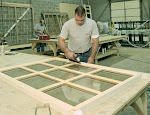
Metal fasteners are a common element to most historic windows; often applied to wood stops, stile and rail joints, and trim. Since the most common installation involves setting the nail and covering it with a wood or epoxy filler, most people don’t pay much attention to the quality of their fasteners. There is often a significant difference in the cost of a stainless steel nail and a conventional steel one, tempting many manufacturers and contractors to take the less expensive alternative. This can prove to be a major mistake in the long run.
When a fastener begins to corrode in a historic window, it will cause the finish and any applied fillers to fail. That accelerates the fastener corrosion and opens the window system up for wood rot. We have seen many installations across the country where the entire window system has deteriorated just due to the use of corrosive fasteners. The attached picture features what can happen after only five years to a window stop with a corroded fastener. In this case the corroded fastener initiated a chain reaction of failures, causing the entire lower rail of the window to rot.
Most people know you should use fasteners specifically designed for exterior applications. The most common of these are zinc plated and galvanized. Galvanized coatings are most often thicker than zinc so they have a more durable coating. Galvanized nails are available in several different types and grades of quality, depending upon the thickness of the coating and the coating process. You can get mechanically plated, hot galvanized, electroplated, and hot dipped. All of these have a zinc coating which is applied to a standard steel nail.
Unfortunately, we have had problems with using galvanized nails for the fabrication and installation of historic windows. During the process of setting the nail, the galvanized coating is compromised due to the force required to drive the nail and the friction with the substrate. The galvanized coating can also react with many of the wood preservatives commonly used. Since wood preservative is typically used on soft woods like pine or fir, this will cause premature corrosion of the fasteners. It is also believed that the acids and chemicals inherent in cedar and redwood can cause corrosion of the coatings on galvanized nails.
We recommend the exclusive use of stainless steel fasteners for any fastener that could be exposed to moisture over the life of the window system. Since it cannot be assumed that the owner of the window will properly maintain the window, it makes sense that all fasteners should be stainless. It is important to note that there are varying degrees of quality in stainless fasteners. Type 304 stainless steel nails contain 18 percent chromium and 8 percent nickel. These nails are highly resistant to corrosion in most environments, but will corrode in more intense conditions such as marine climates. Type 316 stainless contains molybdenum which makes it resistant to salt spray found in ocean climates. We recommend type 316 stainless steel fasteners. Upfront they are more expensive, but over the long term they are an excellent investment.






No comments:
Post a Comment